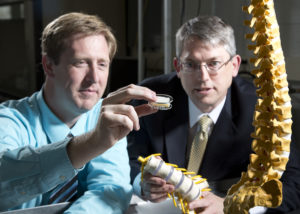 Biomedical Engineers at Brigham Young University have developed a cutting-edge artificial spinal disc that mimics the function of a natural disc. Developers Anton Bowdon, Larry Howell, and Peter Halverson hope their innovative artificial disc will serve as a new option for those suffering from severe back problems caused by disc degeneration, spinal stenosis (“progressive narrowing of the spinal canal”), and back fractures.
Biomedical Engineers at Brigham Young University have developed a cutting-edge artificial spinal disc that mimics the function of a natural disc. Developers Anton Bowdon, Larry Howell, and Peter Halverson hope their innovative artificial disc will serve as a new option for those suffering from severe back problems caused by disc degeneration, spinal stenosis (“progressive narrowing of the spinal canal”), and back fractures.
Those suffering from chronic back pain often face a limited number of options. For many, the choice is either a lifetime of pain medications and a reduced quality of life or major back surgery. Fusion surgery, the most common solution to severe chronic back pain, is a costly and extensive procedure that involves the fusion of two or more vertebrae. It comes with a host of associated risks, and around a fifth of cases fail to relieve the patient’s suffering. Even when successful, fusion surgery results in reduced mobility.
Howell believes that his team’s artificial disc “has a lot of promise for eventually making a difference in a lot of people’s lives.” It will provide a “more human-like, more natural” solution to those with severe back pain.
Congratulations to Howell and his team of engineers for developing this life-enhancing medical device. May they profit handsomely from it.
Like this post? Join our mailing list to receive our weekly digest. And for in-depth commentary from an Objectivist perspective, subscribe to our quarterly journal, The Objective Standard.
Related:
- Review: Crashing Through: The Extraordinary True Story of the Man Who Dared to See
- New Prototype Shows Promise in Medical Diagnostic Imaging
Image: Brigham Young University


![[TEST] The Objective Standard](https://test.theobjectivestandard.com/wp-content/uploads/2017/10/logo.png)







